The Glens of Antrim, a series of nine mesmerizing valleys in Northern Ireland, offer an enchanting journey through a landscape steeped in myth, legend, and natural beauty. With each glen possessing its own distinctive history and character, your exploration will unveil breathtaking scenery, captivating wildlife, and vibrant local culture. Are you ready to experience the enchanting allure of the Glens of Antrim?
Key Takeaways
Explore the captivating valleys of Northern Ireland’s Glens of Antrim, formed by glaciers and volcanic eruptions
Uncover a variety of unique attractions including castles, waterfalls and ancient relics along the Causeway Coastal Route
Enjoy cultural experiences such as local folklore, festivals & events or indulge in regional cuisine at one of many restaurants
Unveiling the Nine Glens of Antrim
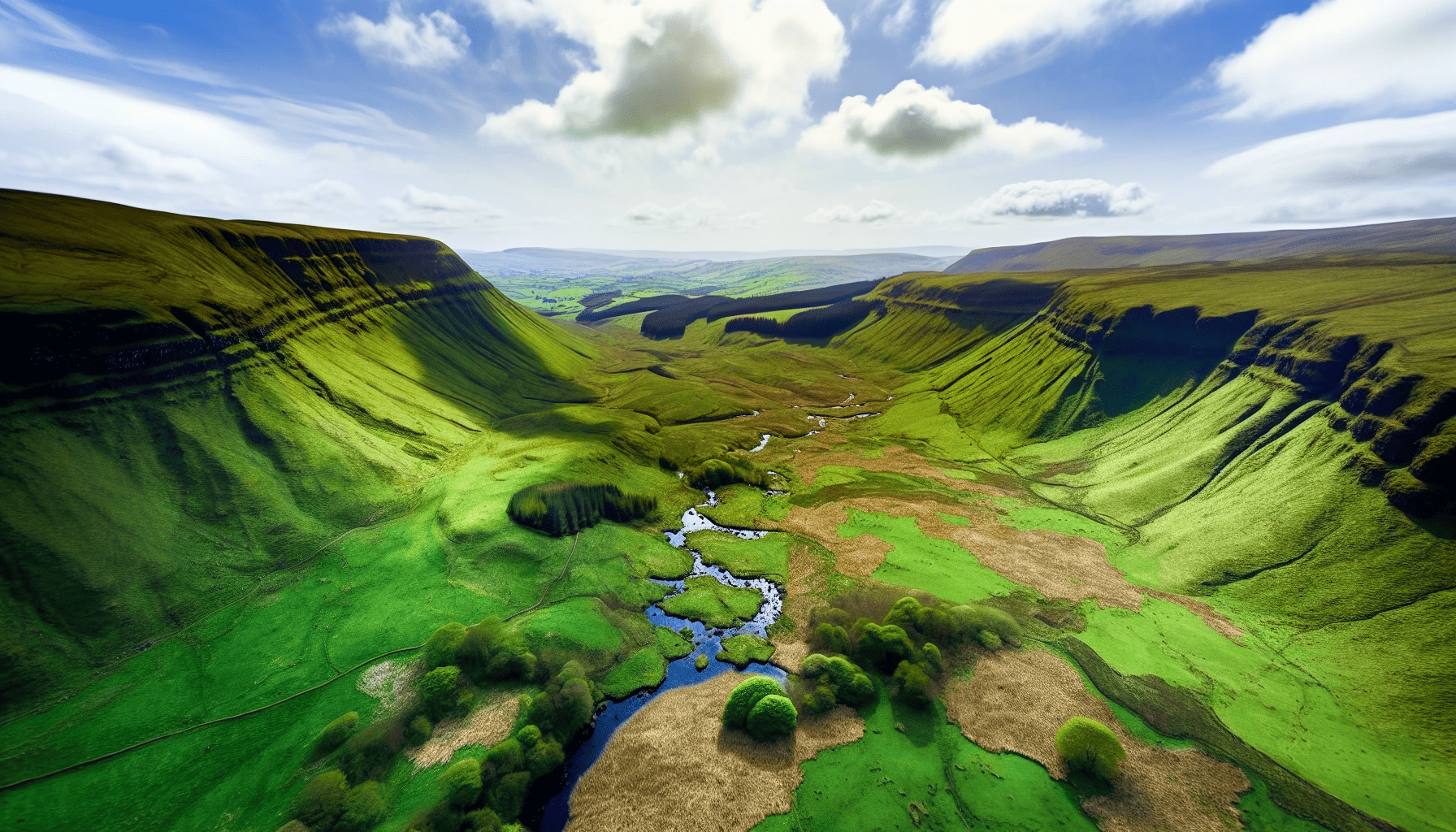
Each of the nine glens, situated in North Antrim, Northern Ireland, possesses its own unique history, character, and natural beauty, providing an unparalleled experience for visitors. Imagine exploring Glenarm Castle, Glencloy’s waterfalls, or the breathtaking panoramas of Rathlin Island, all nestled within these captivating valleys. Officially recognized as an Area of Outstanding Natural Beauty in 1988, the Glens of Antrim are a testament to the region’s awe-inspiring landscapes.
Each glen has its own distinct charm, from the picturesque Glenaan with its traditional Irish cottages and tales of mythical warriors, to Glendun, known as the ‘Brown Glen,’ and its serene strolls along the River Dun. Meandering through the glens, their lush greenery, rolling hills, and dramatic coastlines – the quintessence of the Glens of Antrim, will seize your attention.
The Formation of the Glens
The Glens of Antrim owe their stunning landscapes to the powerful forces of nature. Formed through a combination of geological processes, including erosion by glaciers and the action of rivers, the area was shaped by the movement of ice during the last Ice Age, carving out deep valleys and creating the distinctive landscape we see today. The thin glacial superficial deposits found in the upland area serve as evidence of the significant role glaciers played in the formation of the Glens.
One enthralling journey that narrates the grand stories of the Glens of Antrim is the Moyle Way. This 26-mile trek leads you through remarkable vistas of rivers, ancient monuments, and rolling hills that extend as far as the horizon. The ultimate destination of the Moyle Way is the Glenariff Forest Park, where the sights, sounds, and fragrant aroma of the forest envelop you, creating an unforgettable experience.
The Antrim Plateau
The Antrim Plateau is an extensive area of elevated terrain that constitutes the main ridge of the Glens of Antrim, its geological formation largely composed of basaltic rocks formed through volcanic fissure eruptions. The most remarkable features of the Antrim Plateau are the basaltic rocks formed by extensive volcanic eruptions and lava flows, with the topmost layer of the plateau composed of tough, black basalt lava that erupted from profound fissures in the Earth’s crust.
The Antrim Plateau is also famed for its unique basaltic rocks that emerged as a result of extensive volcanic fissure eruptions and lava flows. Notable among the geological features in the area is the Giant’s Causeway, which is part of the Antrim Plateau and is an extensive lava field. The unique geological features of the Antrim Plateau add to the allure of the Glens of Antrim, creating a fascinating backdrop for your exploration.
Navigating the Causeway Coastal Route
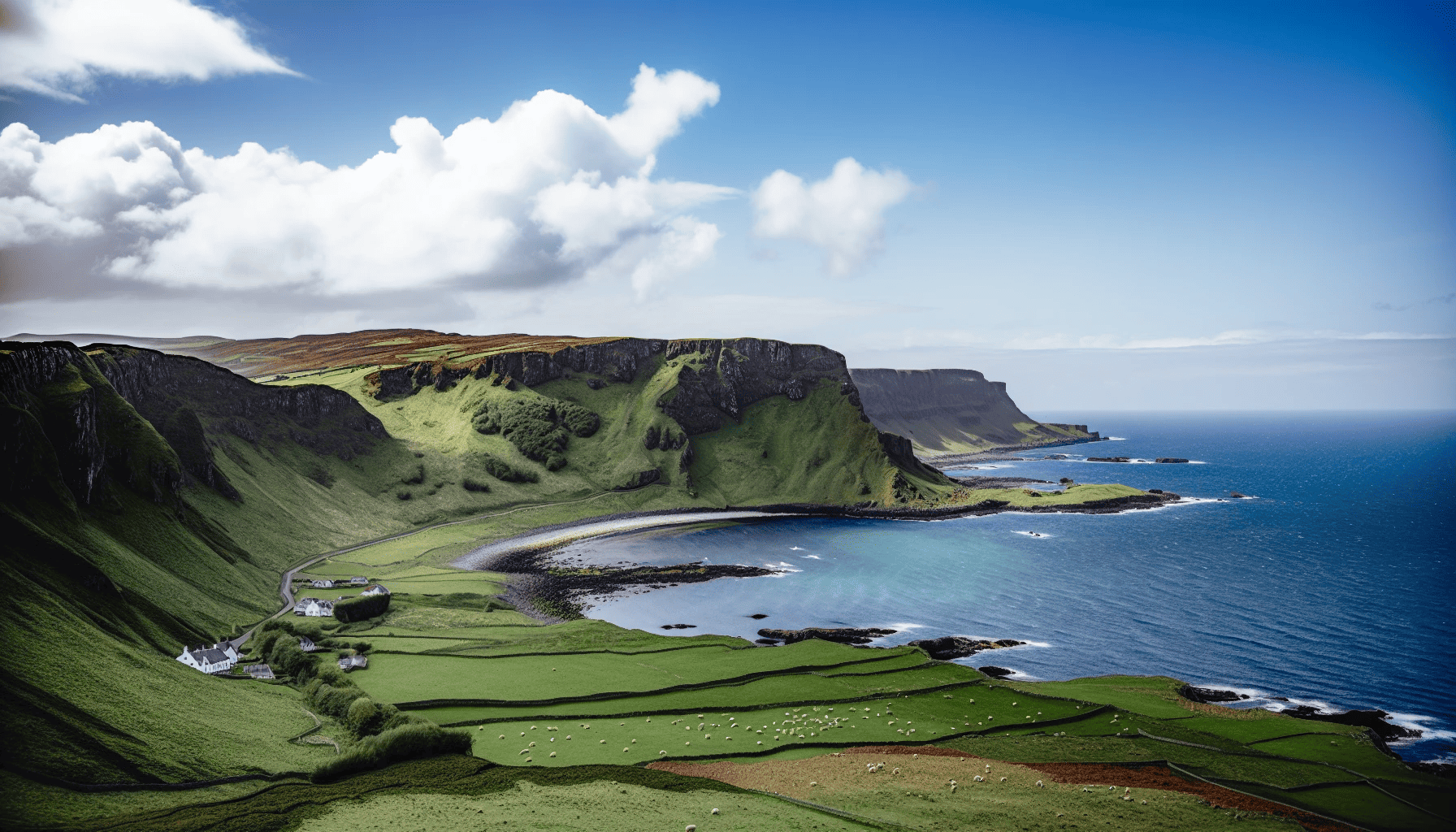
Known as the Antrim Coast Road, the Causeway Coastal Route is a picturesque drive that meanders through the Glens of Antrim, allowing access to stunning vistas and hiking trails. Along the way, you’ll encounter essential stops such as:
Carrickfergus Castle
The Gobbins
Glenarm Castle & Gardens
Torr Head
Each offering a unique glimpse into the region’s rich history and natural beauty.
It is generally believed that it takes approximately three to five days to traverse the entirety of the Antrim Coast Road, allowing ample time to explore the individual glens, hike the renowned trails, and immerse yourself in the stunning scenery. Whether you’re a seasoned hiker or simply seeking a leisurely drive through the countryside, the Causeway Coastal Route offers an unforgettable journey through the heart of the Glens of Antrim.
Driving the Antrim Coast Road
Driving along the Antrim Coast Road, the magnificent stretches of grass and low stone walls, grazing sheep, forests, sheer cliffs, and splendid beaches plunging into the Atlantic will seize your fascination. The road takes you through each of the nine glens, showcasing their stunning landscapes and unique features. One such example is the Glendun Viaduct, a renowned structure that stands tall above the Glen road and river in Glendun, offering a striking sight for travelers.
Your journey along the Antrim Coast Road can be tailored to your schedule, typically ranging between 2 and 4 hours, offering plenty of stops to appreciate the scenic views or enjoy a relaxed walk through the alluring villages and seaside towns. The Antrim Coast Road is truly a must-see when exploring the Glens of Antrim, offering a perfect blend of natural beauty and cultural experiences along the way.
Hiking Opportunities
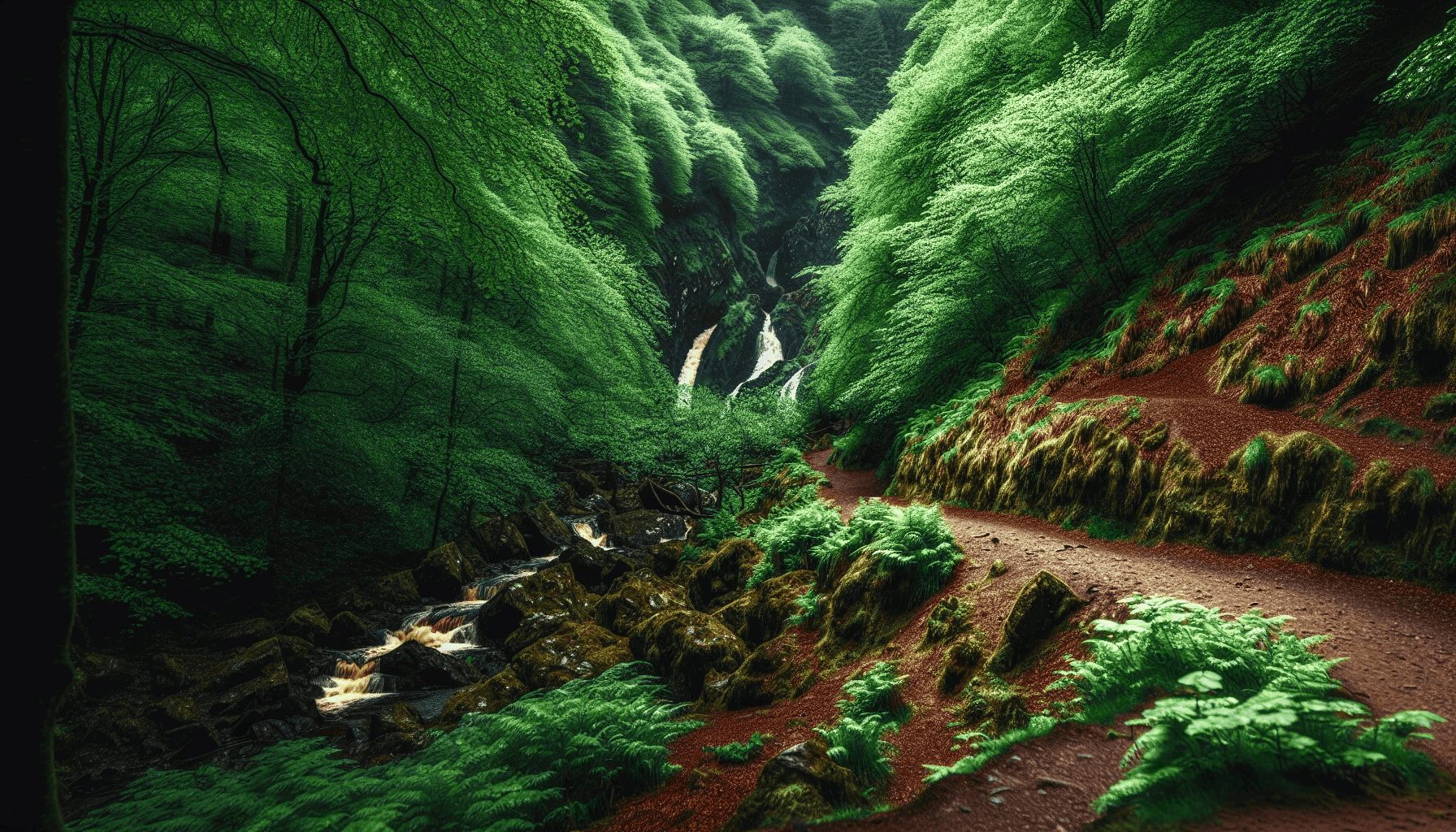
For those yearning for a more active escapade, the Glens of Antrim propose a range of hiking opportunities. The Moyle Way, a marked walking route traversing five of the nine Antrim Glens, presents a challenging two-day walk with waterfalls, wildlife sightings, and a variety of woodland ecosystems. Another popular attraction for hikers is Glenariff Forest Park, a nature park with various hiking trails, including the Scenic Trail, Laragh Lodge, Inver River, and Ess-na-Crub Waterfall.
Glenballyeamon, one of the glens, is known for its derelict railway station, offering visitors a chance to explore a unique piece of local history. In addition, the glen is home to several picturesque waterfalls, providing a stunning backdrop for a wooded riverside walk. Whether you’re a seasoned hiker or simply looking for a leisurely stroll through the lush greenery, the Glens of Antrim cater to all levels of difficulty and present an opportunity to immerse yourself in the breathtaking landscapes.
Delving into the Individual Glens
Every one of the nine glens brings its own unique features, history, and attractions, enabling you to delve deeper into the heart of the Glens of Antrim and genuinely experience their allure. Some highlights include:
Glenaan: ancient relics
Glendun: striking valleys and caves
Glenarm Castle and Gardens
Glencloy: picturesque waterfalls
Glenariff Forest Park
Along the way, just a few miles north, you’ll encounter breathtaking scenery, captivating sights, and more.
Immersing yourself in the individual glens, you’ll enter a world of natural beauty, vibrant local culture, and a rich historical tapestry. Each glen offers its own unique charm and attractions, ensuring an unforgettable experience for every traveler. So, whether you’re seeking adventure, relaxation, or simply a chance to connect with nature, the Glens of Antrim provide the perfect backdrop for a memorable journey.
Glenarm: Castles and Gardens
Glenarm, the southernmost of the nine glens, is home to Glenarm Castle and Gardens, a historic castle and the ancestral abode of the McDonnell family. The castle grounds boast a spectacular walled garden and walking trails, offering an idyllic setting for a leisurely stroll or a moment of quiet reflection. In addition to the castle, the glen is rich in ancient sites and historical ruins, such as the remnants of Templeoughter Church and the upper church, providing a fascinating glimpse into the region’s storied past.
The charming village of Glenarm, nestled within the glen, offers a picturesque backdrop for your exploration of the area. From the quaint streets and traditional architecture to the friendly locals and welcoming atmosphere, Glenarm provides an authentic taste of the Glens of Antrim. Whether you’re visiting the castle, exploring ancient sites, or simply soaking in the natural beauty of the glen, Glenarm is an essential stop on your journey through the Glens of Antrim.
Glencloy: Waterfalls and Game of Thrones
Glencloy, known as the ‘Glen of the Hedges,’ is celebrated for its beautiful waterfalls and Game of Thrones filming locations. The charming village of Carnlough is a must-visit, with its picturesque harbor area and the White Arch over the coast road. In addition to its natural beauty, Glencloy is rich in history, as it was likely a major site for flint weapon production, and the limestone cliffs surrounding the glen have been the source of a vibrant mineral industry.
As a Game of Thrones fan, you’ll be delighted to find a door located in the local hotel, as well as Cushendun Village, which serves as a filming location for the show. The Cushendun Caves, an iconic filming site, are just a stone’s throw away. After your visit to the filming locations, why not take a leisurely hike to Cranny Falls or Doonan Waterfall, both offering stunning views and a chance to connect with nature?
Glencloy presents a perfect blend of natural beauty, history, and pop culture, making it an unforgettable stop on your Glens of Antrim journey.
Glenariff: The Queen of the Glens
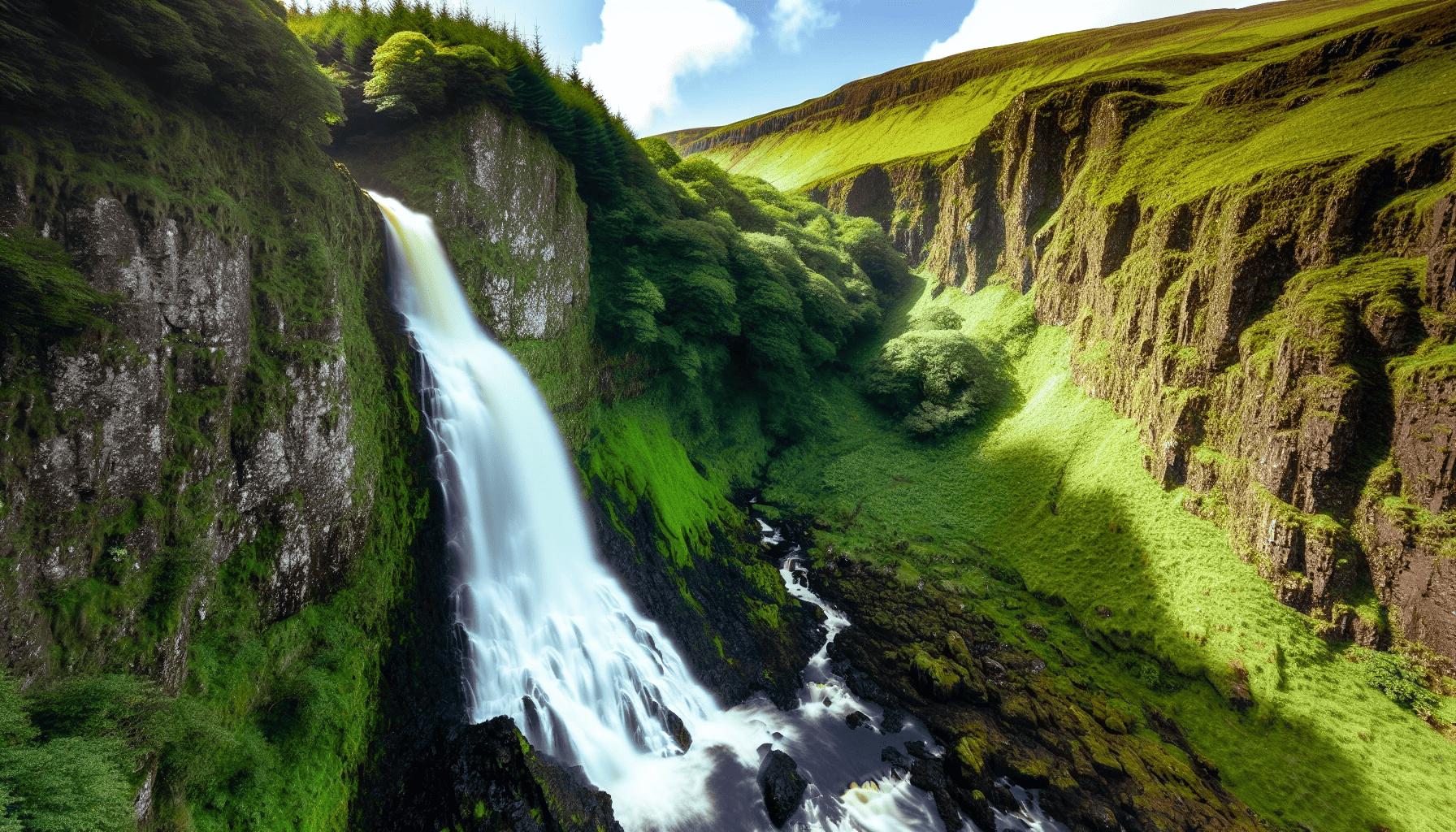
Glenariff, often referred to as the “Queen of the Glens,” is the largest and most popular glen in the region, offering a wealth of attractions and opportunities for exploration. At the heart of the glen, you’ll find Glenariff Forest Park, a nature park offering various hiking trails and the chance to experience the breathtaking beauty of the Glens of Antrim.
The park is home to several attractions, including:
The renowned Waterfall Walkway, a scenic trail that takes you through lush woodland and past several awe-inspiring waterfalls, including the famous Ess-na-Crub Waterfall
A variety of trails that allow you to explore the park and its natural beauty
The opportunity to immerse yourself in the sights, sounds, and fragrances of the forest
Visiting the park offers a truly immersive experience.
Whether you’re an avid hiker or simply seeking a place to unwind and appreciate the natural beauty of the Glens of Antrim, Glenariff offers an unforgettable experience that should not be missed.
Wildlife and Flora in the Glens
The Glens of Antrim host a diverse range of wildlife and flora, including native species like the red grouse, peregrine falcon, common buzzard, and a variety of bird species. The region is also home to several rare and endangered species, such as the fen violet, Irish whitebeam, great burnet, meadow crane’s-bill, and wood crane’s-bill, making it a haven for nature enthusiasts and conservationists alike.
In addition to the abundant wildlife, the Glens of Antrim boast a rich and varied plant life, with a particular flower found in only three places in Northern Ireland, including the Glenarm area. From the verdant forests to the rolling hills and dramatic coastlines, the Glens of Antrim offer a unique and diverse ecosystem for visitors to explore and appreciate.
Native Species
The indigenous species of the Glens of Antrim bear witness to the region’s rich biodiversity. Birdwatchers will be delighted to find a variety of avian species, including:
blackcap
willow warbler
chiffchaff
tree creeper
jay
red grouse
whinchat
dipper
Mammals such as red deer, badgers, foxes, and bats also call the Glens home, providing ample opportunities for wildlife sightings.
In addition to the diverse fauna, the Glens of Antrim are home to a plethora of native plants, including:
Bluebell
Wood anemone
Wild garlic
Ulex europacus
Ulex galii
Dryas octopetala
Minuartia verna
Ajuga pyramidalis
Spiranthes romanzoffiana
Saxifraga hirculus
Carex pauciflora
These species contribute to the rich tapestry of life within the Glens, offering a vibrant and ever-changing landscape for visitors to explore.
Conservation Efforts
Several conservation organizations that inhabit the Glens of Antrim include:
Glens of Antrim Historical Society
Glens Red Squirrel Group
Glens of Antrim AONB Unit
National Trust
These organizations work together to protect the unique ecosystems and wildlife found in the Glens, ensuring the preservation of the region’s natural beauty for future generations.
The Causeway Coast and Glens Heritage Trust has implemented a project called the Heart of the Glens Landscape Partnership Scheme. The project aims to conserve and enhance the natural and historic splendor of the Glens of Antrim. It supports:
Citizen science opportunities
Community conservation efforts
Heritage skills training
Educational/outreach activities
All of these initiatives are aimed at preserving the rich biodiversity and unique landscapes of the Glens of Antrim.
Cultural Experiences in the Glens of Antrim
Exploring the Glens of Antrim, you’ll get the chance to immerse yourself in the region’s rich cultural experiences, ranging from local legends and folklore to festivals and events. The glens are steeped in mythology, with tales of:
fairies
banshees
shape-shifters
kelpies
mermaids
the legendary Fianna and their warrior leader, Finn
In addition to the captivating folklore, the Glens of Antrim host a variety of festivals and events, such as the Glens of Antrim Storytelling Festival and the Heart of Glens Festival, which celebrate the region’s heritage and offer visitors a unique insight into the local culture. These occasions bring the community together and showcase the vibrant traditions, music, and history of the Glens of Antrim.
Local Legends and Folklore
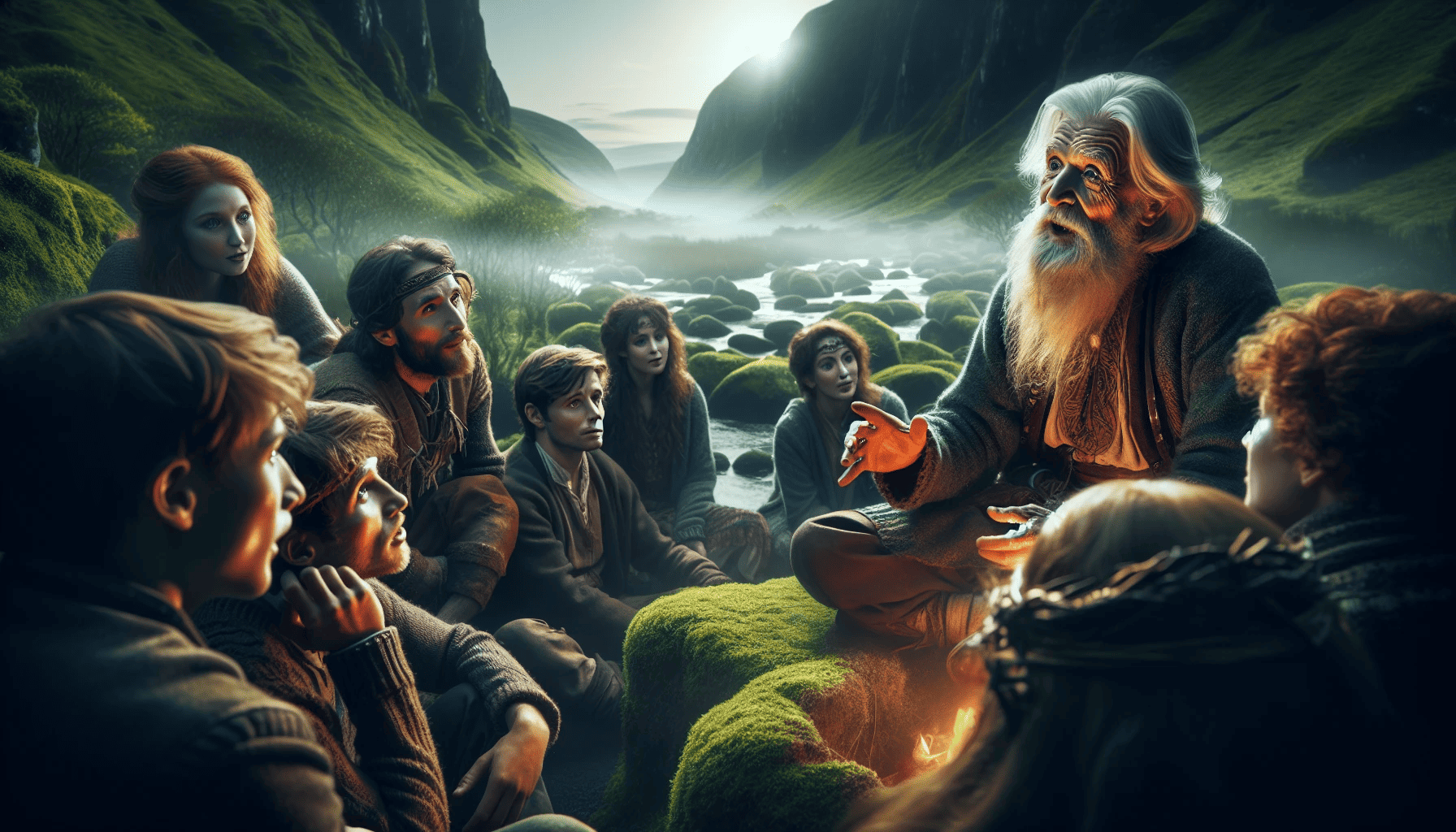
The local legends and folklore of the Glens of Antrim are an integral part of the region’s cultural legacy, deeply rooted in ancient Gaelic literature and mythology. Stories of mythical creatures, ancient warriors, and mysterious landscapes add a layer of mystique to your exploration of the Glens. The belief in:
fairies
banshees
ghosts
the ‘wee folk’
serve as a testament to the strong connection to Irish folklore and superstitions in the Glens of Antrim.
One particularly fascinating legend is the story of the Fianna, a band of warrior men who traversed the wilds of Ireland, including the Glens of Antrim. They were renowned for their courage and heroic deeds. As you delve into the local legends and folklore, you’ll find that they not only add an element of enchantment to your journey but also provide a deeper connection to the vibrant cultural heritage of the Glens of Antrim.
Festivals and Events
Festivals and events in the Glens of Antrim offer visitors the chance to appreciate the local community and its essence. These occasions afford the community to come together, exhibit traditional arts and music, and honor the history and customs of the Glens. Some examples of festivals and events in the Glens of Antrim include:
The Glens of Antrim Storytelling Festival, which celebrates the heritage of the Antrim Coast and Glens through storytelling
The Glens Vintage Rally, which showcases vintage vehicles and machinery
The Glenarm Shindig, a music festival that features local and international artists
These events provide a unique opportunity to immerse yourself in the culture and traditions of the Glens of Antrim.
Other notable events include the Heart of the Glens Festival, the Glenarm Castle Highland Games, and the Cushendun Big Arts Weekend, each providing a showcase of the region’s rich culture and vibrant traditions.
By attending these festivals and events, you’ll gain a deeper understanding of the Glens of Antrim’s cultural heritage and create lasting memories of your time in this enchanting region.
Accommodations and Dining in the Glens of Antrim
After a day spent exploring the stunning landscapes and rich culture of the Glens of Antrim, finding the perfect accommodations and dining options will complete your experience. The region presents a variety of charming B&Bs, hotels, and restaurants serving local cuisine, ensuring a comfortable stay and a sampling of the local flavors.
Whether you’re seeking a cozy B&B nestled in the heart of a picturesque village or a luxurious hotel with sweeping views of the coast, the Glens of County Antrim have something to suit every traveler’s taste and budget. And when it comes to dining, you’ll find a variety of local cuisine and restaurants that showcase the region’s culinary traditions and fresh, local ingredients.
Charming B&Bs and Hotels
Select from a range of charming B&Bs and hotels in the Glens of Antrim, each providing comfortable stays and warm hospitality. Some top-rated accommodations include:
Glenn Eireann House
Teach an Cheoil
Cullentra House
Antrim Coast Apartments
Glendale Bed and Breakfast in Cushendall
The Salthouse Hotel
These establishments boast distinctive features such as remarkable seafront locations and a blend of traditional style with modern comforts.
When selecting accommodations, consider factors such as:
guest reviews
promotions and discounts
proximity to the glen you wish to explore
available amenities
the location’s suitability for visiting nearby attractions
By choosing the perfect accommodations, you can ensure a memorable and comfortable stay in the enchanting Glens of Antrim.
Local Cuisine and Restaurants
Relish the local cuisine and restaurants in the Glens of Antrim, displaying the region’s culinary traditions and fresh, local produce. Northern Irish cuisine, including wheaten bread, potato bread, veda bread, and soda farls, is a delight for the senses. In addition, the Glens are home to an array of delightful restaurants, such as Harry’s Restaurant, The Red Door, The Londonderry Arms Hotel, The Bay Cafe, and The Bushmills Inn.
By indulging in the local cuisine, you’ll not only satisfy your taste buds but also gain a deeper appreciation for the region’s culinary heritage. From traditional dishes to contemporary creations, the Glens of Antrim offer a dining experience that is sure to leave a lasting impression on your palate.
Summary
The Glens of Antrim present a captivating journey through a landscape steeped in history, mythology, and breathtaking natural beauty. With each glen offering its own unique charm, visitors can immerse themselves in the enchanting allure of Northern Ireland’s countryside. From the stunning landscapes and rich wildlife to the vibrant local culture and charming accommodations, the Glens of Antrim provide an unforgettable experience for every traveler. So why not embark on your own adventure and uncover the magic of the Glens of Antrim for yourself?
Frequently Asked Questions
What are the 7 Glens of Antrim?
The seven Glens of Antrim, located along the Causeway Coastal Route, are Glenarm, Glenaan, Glenballyeamon, Glencloy, Glenariff, Glenshesk and Glenoe.
Where are the 9 Glens of Antrim?
The Nine Glens of Antrim are a breathtaking collection of deep valleys that span the north coast of the Emerald Isle. They dominate the 80 miles of cliff and were formed during the Ice Age when melting glaciers cut into the land. The main towns and villages in the Glens are Ballycastle, Cushendun, Cushendall, Waterfoot, Carnlough and Glenarm, located on the eastern and northern sides of the Antrim Plateau.
How many Glens are there in Northern Ireland?
There are nine Glens in Northern Ireland, radiating from the Antrim Plateau to the coast and inhabited by descendants of native Irish and Hebridean Scots.
What does Antrim mean in Irish?
Antrim in Irish means “lone ridge”. The name comes from the Irish Aontroim and is associated with County Antrim, one of the six counties of Northern Ireland. It is located within the historic province of Ulster and is known for its unique geological wonders such as The Giant’s Causeway.
What is the Antrim Coast Road?
The Antrim Coast Road, also known as the Causeway Coastal Route, is a breathtaking route that takes you through the beautiful Glens of Antrim.

